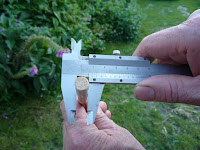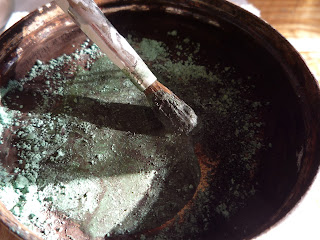Fun to make and fascinating to watch,
these insect hotels can make all the difference to the successful
pollination of your fruit and vegetables and also to the control of
pests by insect predators.
Open for Business - Build Your Own Green Hotel
Here's our deluxe version and in the next post I will be featuring our designs for 'Eco Lodges' smaller hanging and nestling accommodation you can place around the garden or orchard. They also make great presents, not only for Christmas but also in this larger form an ideal Wedding Gift.
Here is a close up of what an occupied room looks like - in this case the 'door' is closed with clay but some creatures like the leaf cutter bee.. yes it's all in the name!
Larger arthropods we find in our garden and have photographed, can overwinter in the larger stems and or bark and leaf infill.

Some of these like the larvae of the Stag Beetle are becoming ever more rare, so providing them with a permanent shelter is a great idea. The larger stems will also be able to accommodate the beautiful large European Black solitary bee, again another species, who is threatened by extinction.
This is a great project to do with kids as there is a massive selection of differing natural materials to be sought from within the garden or further afield in woods and hedgerows. The end result can be quite artistic the only limit is your imagination. Children also enjoy seeing who is using the Hotel and can observe the essential role insects play in nature, for pollination and pest control.
Some of the materials we found for the Hotel, dried teazle heads, fir cones, dry branches, various dry flower and vegetable stems, dry bamboo canes and leaves, moss and lichens and of course pallet blocks.
Making the Hotel Frame
The structure is a rectangular frame with shelves within surmounted with a triangular apex. It is simply nailed together, including the rear wall of tongue and groove planking, which ensures that the hotel remains square and rigid.
I selected 100mm (4") wide untreated pallet wood planks.
The bottom, top and shelves were cut 50cm long. The two vertical sides were cut 50 cm plus twice the plank thickness.
The vertical sides are nailed into the end-grain of the top and bottom pieces and to ensure that the nails do not split the wood this close to the edge, I drilled pilot holes for them.
I used a 2mm drill for the holes, the nails are 2.4mm in diameter.
When nailing the sides I made sure that the rear edges of the planks were level with each other.......
.......and the corners remain square.
I used pallet blocks (pre-drilled for use in the Hotel in this image) to set the distance between each shelf. I found it easier to drive the nails into the end grain of the shelf if I once again drilled pilot holes at the appropriate positions in the vertical side walls.
The triangular section at the top of the structure has a 90° angle at its apex. I initially had cut a 45° angle where it met the edge of the vertical side but I thought this was unnecessarily difficult so I just cut a square edge as illustrated. I found there was no structural difference in doing this and as the wire mesh on the front face was held in place with quarter-round beading this joint was hidden from view.
I had marked a centre line in the top of the rectangle and used a try-square from this line to determine the lengths for the two angled pieces.
Once again, pilot holes for the nails were drilled. Notice that the drill is vertical to the face of the sloping piece of wood.
When the Hotel is filled with the 'bedding materials', the exposed portions of nails are hidden from view.
The rear wall can now be cut to size and nailed in place. I used tongue & groove panelling 10mm thick. I marked the length and shape of the piece and nailed each one in place before marking and cutting the next one. Pilot holes were drilled and the back wall was nailed to each shelf as well as the rectangular frame and the triangular top.
This, ensured the whole structure was rigid and the, potentially, weak points (where nails were entering the end grain or going in at an angle) were reinforced.
And this is how it looks.
Fitting out your hotel rooms
Now comes the fun bit, filling the Hotel with suitable nesting materials. I used the pallet block as a guide for cutting twigs and branches to length. The 'compartments' between the pallet blocks were filled with an assortment of natural materials as well as these cut stems.
I cleared the pith out of some stems (like the elderberry) with a stiff piece of wire. Some stems were left with the pith as certain insects eat the pith and/or use it to create doors to seal the rooms.
For the twigs, branches, and pallet blocks I drilled holes of between 4mm and 10mm diameter.
Before everything was put in place, straw was packed along the whole back wall of the hotel to provide insulation and extra bedding.
All of this was done with the Hotel laying flat on its back.
Once filled, chicken wire was cut to size and secured with quarter round beading nailed to the front edges of the structure. I used 30mm long panel pins to do this.
A nail punch was used to drive the panel pins' heads flush with the wood surface.
Siting your Hotel
Your Hotel once completed should be sited in a sheltered location and preferably in a South Easterly to South Westerly facing direction. This house is meant to be placed at ground level or hung on a wall. In the next blog I will show how to make the smaller Eco Lodges, motels, chalets and gîtes we designed for placing around the garden, on a balcony and/or hanging in trees.
Beware once made, these insect hotels make addictive watching, people have been known to spend hours observing insects coming in and out of their hotels! Have fun and now, if you'd like to, sit back and watch the film.
For a smaller insect hotel project see our blog post on The Bee Cosy for cosy bees!
Thanks for dropping by and please feel free to share this article, comment, ask questions and if you'd like to be assured of getting the next post, then sign up to follow this blog.
All the best, Andy
© Andy Colley 2014
RELATED ARTICLES
Home-made Insect Hotel from Repurposed Materials
The Bee Cosy for cosy bees is an elegant green gift for you to make using 99% recuperated materials...read more
Home-made Insect Hotels from Repurposed Materials The Gite & The Chalet
Made from repurposed materials, untreated pallet wood, fruit crate wood and general garden debris. To decorate them, we use natural...read more
An Insect Hotel as a Utility Box Cover - Design & Construction
The electricity company brought power to the property but sited the
ubiquitous supply box right in front of the house. Not surprisingly, she
is unhappy...read more
An Insect Hotel as a Utility Box Cover - Roofing & Furnishing
The roof was constructed in a similar fashion to that of a house. The
pitch was 45°. The gable ends supported the ridge purlins/laths...read more
An Insect Hotel as a Utility Box Cover - Installing
Having made the insect hotel, its roof and metal posts in 'kit' form as
it were,it was time to transport it and put it in place...read more






















































